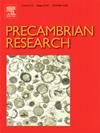安哥拉西南部纳米贝地区的岩石地层、构造和地质年代学格架:对刚果盾晚Eburnean造山运动的认识
IF 3.2
2区 地球科学
Q2 GEOSCIENCES, MULTIDISCIPLINARY
引用次数: 0
摘要
安哥拉西南部的纳米贝地区代表了刚果西南地盾的最南端;然而,对其构造热演化仍知之甚少。为了更好地约束本区露头岩石的时代和变形风格,我们综合了(i) 1:25万尺度的岩石地层和构造地质填图,(ii)变质岩的SHRIMP U-Pb锆石定年,(iii) 40Ar/39Ar白云母冷却年龄。研究区包括正长和副长叶柏杂岩,上覆纳米贝群,由表壳上沉积组成。尖锐的岩性对比、正异性的缺失和基底大理岩的保存表明,纳米贝群的原岩是不整合沉积在埃帕杂岩上的。在Eburnean事件期间,这两个单元都经历了多相韧性变形。两个渗透性变形相(D1和D2)被两个较晚的渗透性较弱的相(D3和D4)覆盖。亚水平的D2剪切带将上地壳的左旋挤压与部分熔融下地壳的横向流动联系起来。峰值变质条件导致广泛的深熔。SHRIMP U-Pb锆石年龄从混染白色小体、花岗-调性正长岩和碎屑-变质锆石紧密聚集在1.82 ~ 1.80 Ga之间,而40Ar/39Ar白云母年龄表明冷却时间为~ 1.80 Ga。这意味着热峰、熔体偏析、花岗岩就位和冷却发生在≤10 Ma。高变质作用和岩浆活动的近同向性,加上地壳尺度的D2剪切构造,支持了一个热增厚地壳在晚eburnee左旋挤压期间经历垂直应变传递的模型。本研究为安哥拉西南部Eburnean晚期事件提供了第一个精确的1.82-1.80 Ga年龄范围,突出显示了一个保存完好的上地壳剪切与深部地壳流动耦合的亚水平附着带。本文章由计算机程序翻译,如有差异,请以英文原文为准。

Lithostratigraphic, structural and geochronological framework of the Namibe region, SW Angola: Insights into the late Eburnean Orogeny in the Congo Shield
The Namibe region in southwestern Angola represents the southernmost extent of the Southwestern Congo Shield; however, its tectonothermal evolution is still poorly understood. To better constrain the timing and deformation style of the outcropping rocks in this region, we integrated (i) 1:250,000-scale lithostratigraphic and structural geological mapping, (ii) SHRIMP U–Pb zircon dating of metamorphic rocks, and (iii) 40Ar/39Ar muscovite cooling ages. The study area comprises the Epupa Complex of ortho- and paragneisses, overlain by the Namibe Group, which is composed of supracrustal metasediments. The sharp lithological contrast, absence of orthogneisses, and the preservation of basal marbles suggest that the protoliths of the Namibe Group were unconformably deposited on the Epupa Complex. Both units experienced polyphase ductile deformation during the Eburnean event. Two penetrative deformation phases (D1 and D2) are overprinted by two later, less pervasive phases (D3 and D4). A subhorizontal D2 shear zone links sinistral transpression in the upper crust with lateral flow in a partially molten lower crust. Peak metamorphic conditions led to widespread anatexis. SHRIMP U–Pb zircon ages from migmatitic leucosomes, granitic–tonalitic orthogneisses, and detrital to metamorphic zircons cluster tightly between 1.82 and 1.80 Ga, while 40Ar/39Ar muscovite ages indicate cooling at ∼1.80 Ga. This implies that the thermal peak, melt segregation, granite emplacement, and cooling occurred within ≤10 Ma. The near-synchronicity of high-grade metamorphism and magmatism, together with the crustal-scale D2 shear architecture, supports a model of hot, thickened crust undergoing vertical strain transfer during late Eburnean sinistral transpression. This study provides the first precise 1.82–1.80 Ga age bracket for the late Eburnean event in southwestern Angola, highlighting a well-preserved subhorizontal attachment zone that couples upper crustal shear with deep crustal flow.
求助全文
通过发布文献求助,成功后即可免费获取论文全文。
去求助
来源期刊

Precambrian Research
地学-地球科学综合
CiteScore
7.20
自引率
28.90%
发文量
325
审稿时长
12 months
期刊介绍:
Precambrian Research publishes studies on all aspects of the early stages of the composition, structure and evolution of the Earth and its planetary neighbours. With a focus on process-oriented and comparative studies, it covers, but is not restricted to, subjects such as:
(1) Chemical, biological, biochemical and cosmochemical evolution; the origin of life; the evolution of the oceans and atmosphere; the early fossil record; palaeobiology;
(2) Geochronology and isotope and elemental geochemistry;
(3) Precambrian mineral deposits;
(4) Geophysical aspects of the early Earth and Precambrian terrains;
(5) Nature, formation and evolution of the Precambrian lithosphere and mantle including magmatic, depositional, metamorphic and tectonic processes.
In addition, the editors particularly welcome integrated process-oriented studies that involve a combination of the above fields and comparative studies that demonstrate the effect of Precambrian evolution on Phanerozoic earth system processes.
Regional and localised studies of Precambrian phenomena are considered appropriate only when the detail and quality allow illustration of a wider process, or when significant gaps in basic knowledge of a particular area can be filled.
 求助内容:
求助内容: 应助结果提醒方式:
应助结果提醒方式:


